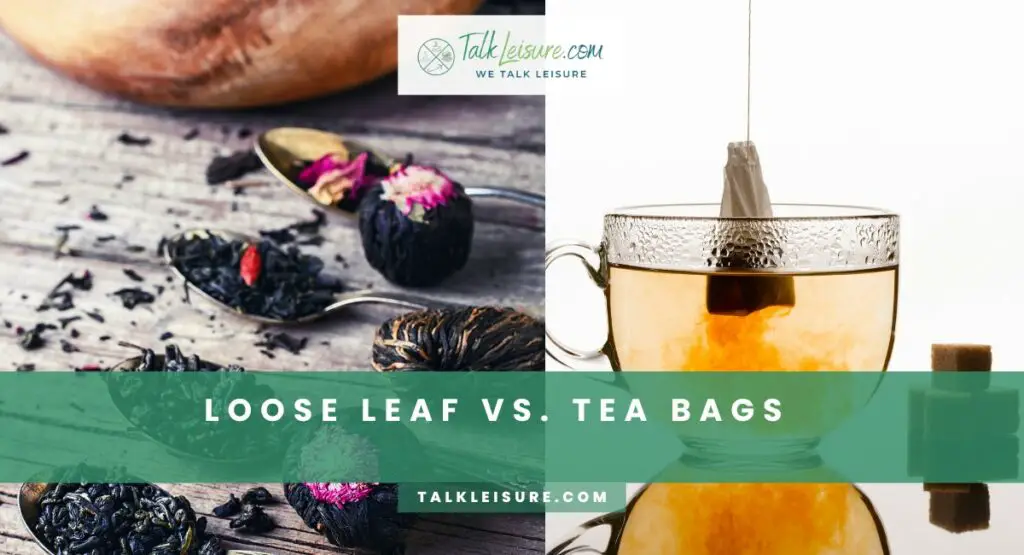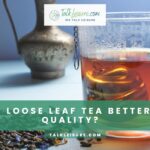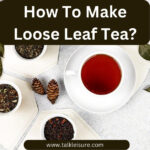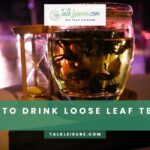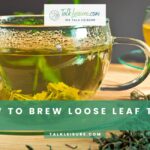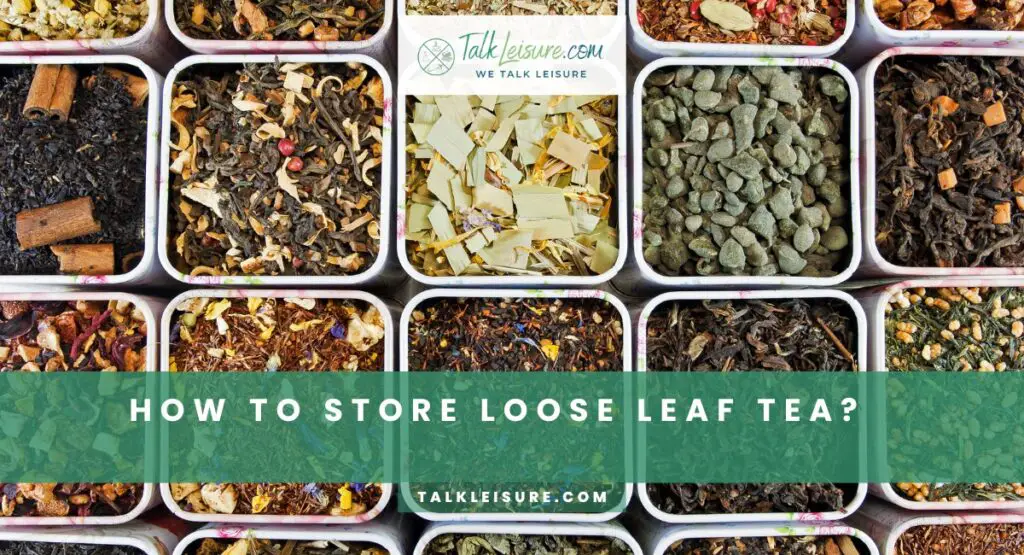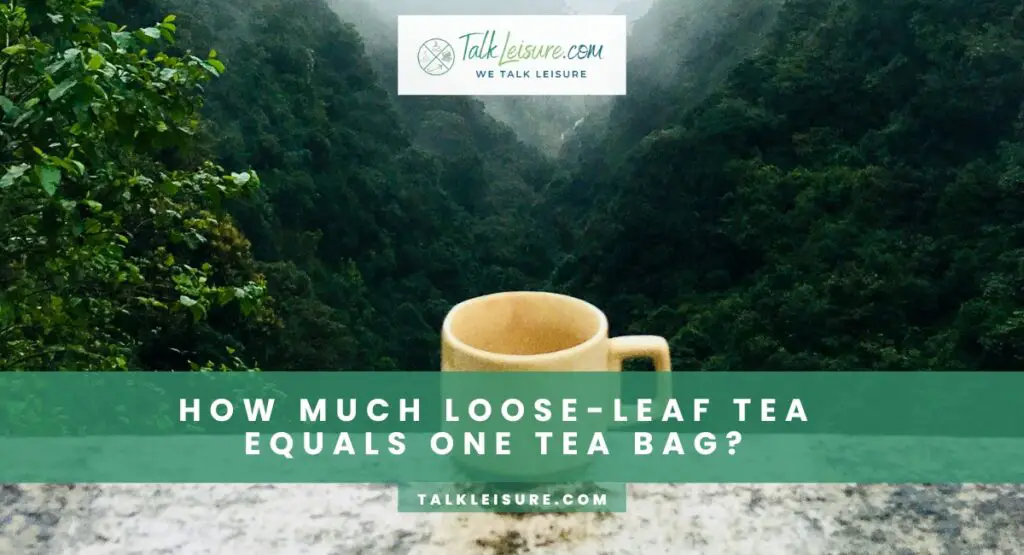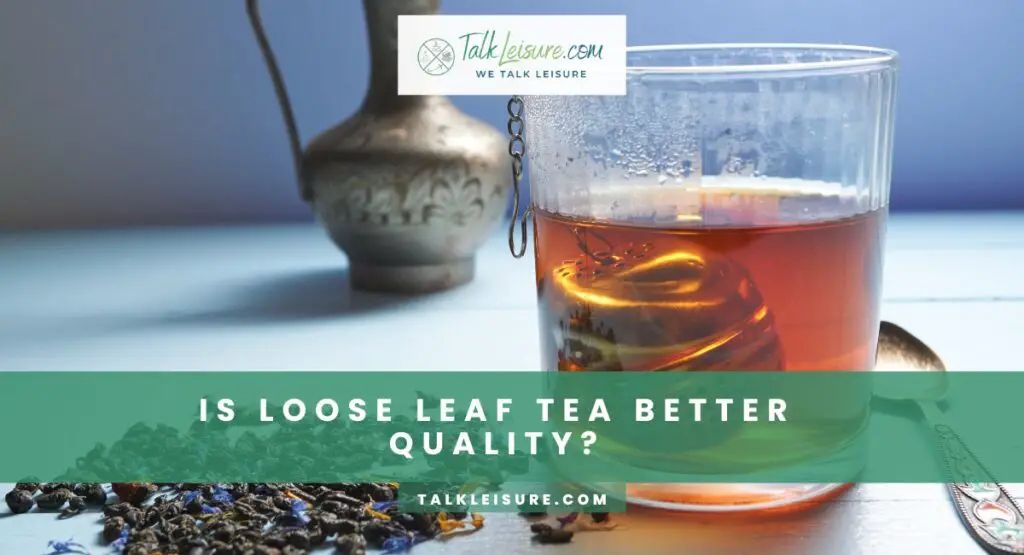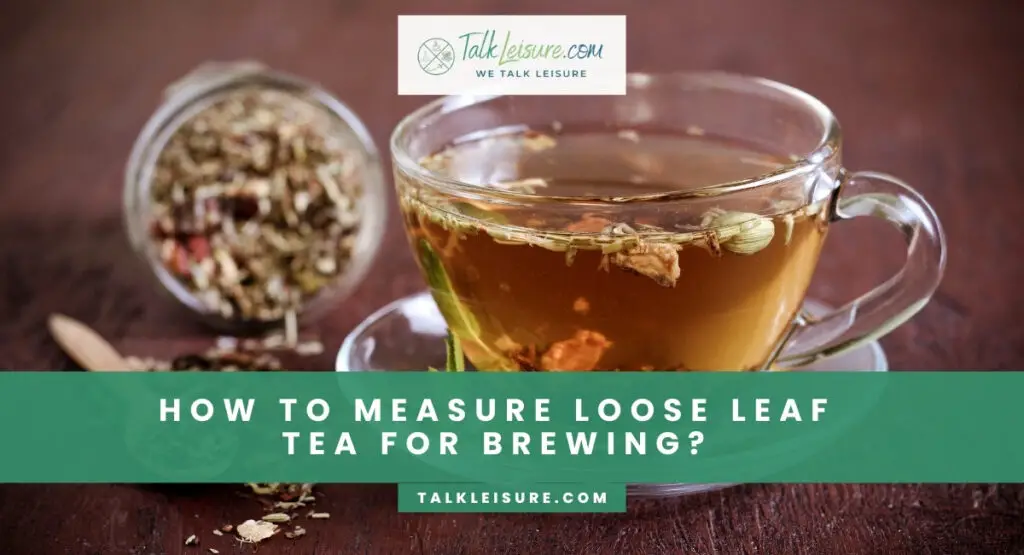Tea is one of the most beloved and widely consumed beverages worldwide.
Whether you’re a tea enthusiast or enjoy a comforting cup, you’ve probably encountered the dilemma of choosing between loose-leaf tea and tea bags.
Each method has its staunch advocates, and the debate on which is superior continues to stir discussions among tea lovers.
However, Loose-leaf tea offers richer flavor and quality, allowing customization, but requires tools and time. Tea bags offer convenience but might compromise taste and quality.
This article delves into tea to understand the fundamental differences between loose-leaf tea and tea bags.
We’ll explore their production processes, taste differences, health benefits, and other factors influencing your tea-drinking experience.
By the end, you’ll better grasp these two popular tea options, allowing you to make an informed decision the next time you brew a cup.
What Is Loose Leaf Tea?
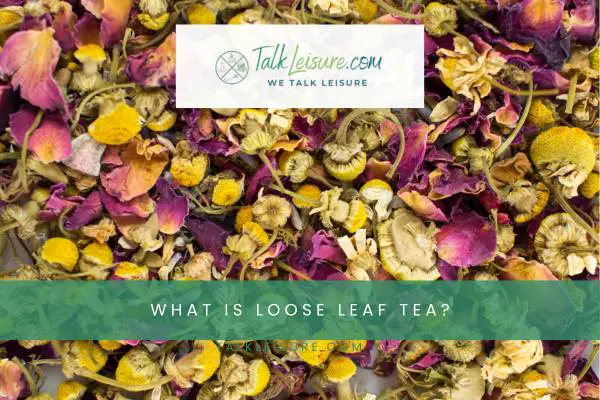
Loose-leaf tea is a traditional form of tea that dates back centuries.
It involves using whole or broken tea leaves not enclosed in a bag or sachet.
Instead, the tea leaves are placed directly into a teapot, infuser, or strainer, allowing ample room to unfurl and release their full flavor during steeping.
The loose-leaf tea preparation process involves plucking young tea leaves, withering to reduce moisture content, rolling to break down cell walls and initiate oxidation, and then firing to halt oxidation.
This process preserves the natural flavors and aromas of the tea, making it a favorite among tea connoisseurs.
What Are Tea Bags?
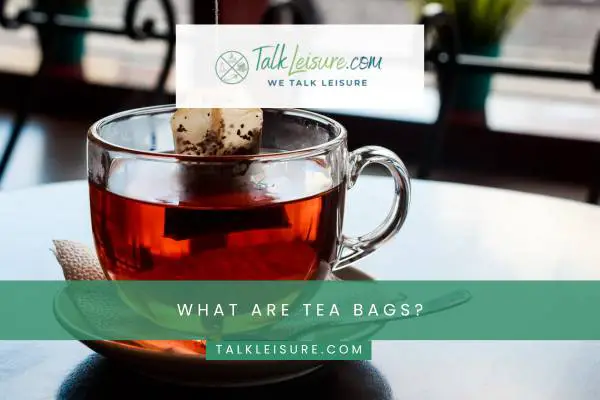
On the other hand, tea bags are a more recent invention and were introduced in the early 20th century.
They are convenient, pre-packaged tea servings made from either tea dust or fannings – the small broken tea leaves left after the highest-quality whole leaves are sorted out.
These tiny tea particles are packed into permeable paper or mesh bags, making steeping easy and mess-free.
Tea bags revolutionized how people brew tea, providing a convenient single-serving option requiring minimal preparation.
However, some tea aficionados argue that convenience comes at the cost of compromising taste and quality.
The Great Loose Leaf Tea vs. Bagged Tea Debate
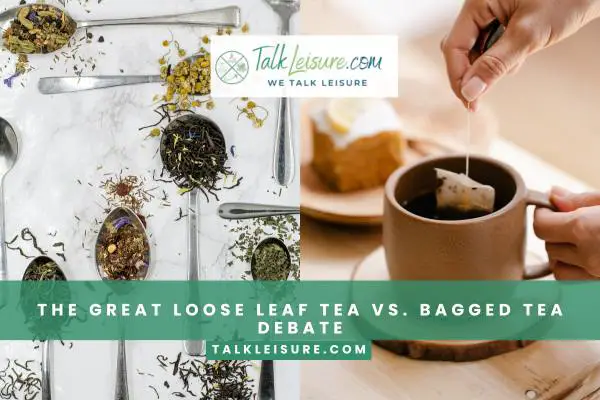
The debate between loose-leaf tea and tea bags has been ongoing for decades, and each camp has its merits.
Let’s explore the primary points of contention between the two:
Here’s a comparison table between loose-leaf tea and tea bags using different columns for comparison:
| Aspect | Loose Leaf Tea | Tea Bags |
|---|---|---|
| Quality | Typically higher quality | Can vary in quality |
| Leaf Size | Whole or large pieces | Smaller, broken leaves |
| Flavor | More complex and nuanced | May have simpler flavors |
| Aroma | Richer and more fragrant | Aroma might be limited |
| Brewing Time | Longer brewing time needed | Quicker brewing time |
| Brewing Space | It needs an infuser or strainer | No additional equipment |
| Customization | Needs an infuser or strainer | Pre-portioned, less control |
| Variety | Wide range of options | Limited variety sometimes |
| Cost | Easily adjust the tea amount | Generally more affordable |
| Sustainability | Less packaging waste | More packaging waste |
| Environmental Impact | Often more eco-friendly | Can contribute to waste |
| Storage | Requires airtight containers | Simple packaging |
| Experience | More involved and ritualistic | Convenient and quick |
What Are The Four Grades Of Tea?
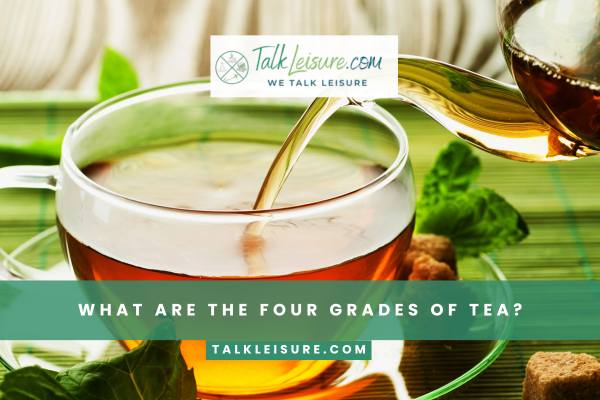
Tea grades are a classification system based on the quality and size of tea leaves. The four main grades are:
a) Whole Leaf Tea: These are the highest-quality tea leaves, including the young, tender buds and the tea plant’s first two to three leaves. Whole-leaf teas are rich in flavor and aroma, offering a superior tea-drinking experience.
b) Broken Leaf Tea: This grade consists of larger, broken pieces of tea leaves, and while the quality may not match whole-leaf teas, they can still produce decent cups of tea.
c) Fannings: Fannings are smaller tea particles, often found in tea bags. They have a quicker infusion time but may lack the flavor complexity in whole or broken-leaf teas.
d) Dust: The lowest grade, tea dust, consists of fine particles left after processing. It is commonly used in lower-quality tea bags and offers a fast brew time but lacks the nuances of higher grades.
Standardization vs. Variety
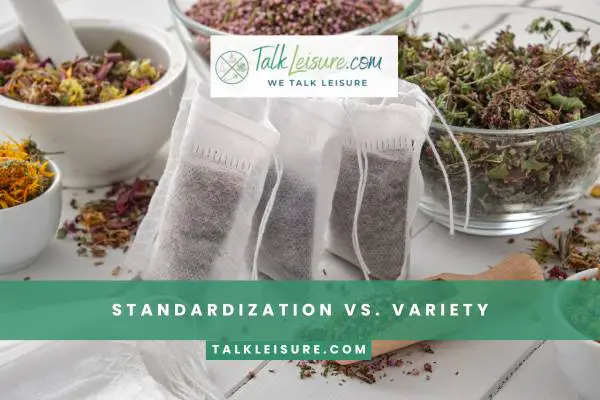
Tea bags, primarily filled with fannings or dust, offer a standardized and consistent flavor profile.
This ensures that every cup tastes the same, which can be reassuring for those seeking familiarity.
On the other hand, loose-leaf tea provides diverse flavors and aromas, even within the same tea type.
This variety caters to the adventurous tea drinker who appreciates subtleties and distinct characteristics in their cup.
Standardization in Loose Leaf Tea:
Consistency: Loose-leaf tea allows for a certain level of standardization in terms of quality and flavor. Reputable tea producers can maintain a consistent blend, appearance, and taste across batches by carefully selecting and processing the tea leaves.
Quality Control: With loose-leaf tea, there’s often more opportunity for quality control. Producers can visually inspect the leaves for defects, ensuring that only the best leaves are included in the final product.
Customization: While there’s a degree of standardization, loose-leaf tea still offers room for customization. Producers can create specific blends by combining tea leaves, herbs, spices, and flowers to achieve desired flavors and aromas.
Variety in Loose Leaf Tea:
Diverse Flavors: Loose-leaf tea offers a wide array of flavors and profiles. Different tea leaves (black, green, white, oolong) and blends allow for a rich diversity of tastes, ranging from earthy and robust to light and floral.
Single-Origin Teas: Loose-leaf tea often includes single-origin options, where tea enthusiasts can experience the unique terroir of specific tea-growing regions, reflecting the nuances of soil, climate, and altitude.
Herbal and Artisan Blends: Beyond traditional tea leaves, loose-leaf tea also includes herbal infusions and artisanal blends, expanding the range of available flavors to include fruits, flowers, and various herbs.
Standardization in Tea Bags:
Consistency and Convenience: Tea bags are known for their consistent flavor and convenience. They offer a standardized taste profile since the tea leaves are pre-measured and enclosed in the bag, reducing the variability of brewing.
Portion Control: Tea bags provide a controlled portion size, making it easier to brew a consistent cup of tea without worrying about measurements.
Quick Brewing: Tea bags are often preferred for their speed. They eliminate the need for measuring loose leaves and using a separate infuser, making them a popular choice for busy individuals.
Variety in Tea Bags:
Limited Diversity: While some tea bags offer different types of tea (black, green, herbal), the variety is more limited than loose-leaf tea. The focus is usually on traditional tea types rather than complex blends.
Blends and Flavored Teas: While flavored tea bags are available, the range of flavors and customization is generally narrower than with loose-leaf teas.
Limited Single-Origin Options: Tea bags offer less in terms of single-origin experiences, as the focus is often on providing a standardized taste that appeals to a broader audience.
Both loose-leaf tea and tea bags have their strengths in standardization and variety.
Loose-leaf tea excels in offering a diverse range of flavors, single-origin options, and customized blends, while tea bags prioritize convenience, consistent brewing, and control portion sizes, though with a somewhat limited range of flavors and customization options. The choice between the two depends on personal preferences for taste, brewing experience, and convenience.
Is Loose Leaf Tea Better Than Tea Bags?
The preference for loose-leaf tea or tea bags is personal taste and priorities.
Loose-leaf tea is generally better than tea bags due to its higher quality, fresher flavor, and more natural processing.
Tea bags often contain broken leaves and dust, making a less flavorful brew.
Loose-leaf tea also offers a wider variety of tea options, including artisan blends. While tea bags are convenient, they can limit the tea’s potential.
If you prioritize flavor and quality, loose-leaf tea is a superior choice.
Taste Differences Between Loose Leaf Tea And Bagged Tea
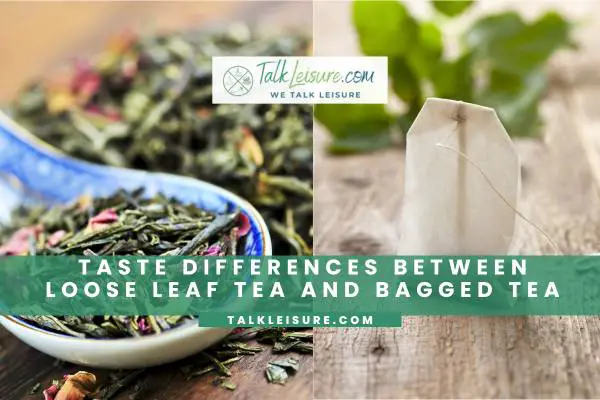
Loose-leaf tea is known for its richer, more complex flavor than tea bags.
The larger tea leaves in loose-leaf tea have more room to expand during steeping, allowing the flavors and aromas to develop fully.
In contrast, tea bags filled with smaller particles can limit the infusion process, resulting in a weaker and less flavorful cup.
Here’s a table outlining some taste differences between loose-leaf tea and tea bags:
| Aspect | Loose Leaf Tea | Tea Bags |
|---|---|---|
| Leaf Quality | Whole or large leaf fragments | Smaller, broken leaf particles |
| Surface Area | The aroma can be somewhat muted | It may provide simpler, less complex flavors |
| flavor extraction | It fits well in small tea bags, suitable for confined | |
| Flavor | It may require a longer steeping time | It may require a longer steeping time |
| Aroma | Typically has a stronger and more aromatic scent | Leaf quality may be harder to judge through the bag |
| Brewing Time | It may require a longer steeping time | Generally requires shorter steeping time |
| Steeping Space | Can adjust the number of leaves for personal | It needs more space for expansion, best in a |
| infuser or pot | spaces like mugs and cups | |
| Customization | Pre-measured bags may limit the customization of tea | Leaf quality may be harder to judge through the bag |
| taste preferences | strength | |
| Quality Control | Easier to assess leaf quality visually | Leaf quality may be harder to judge through bag |
| material | ||
| **Environmental | Generally more eco-friendly as they produce less | Some tea bags are biodegradable, but many are |
| Impact** | waste and can often be composted | made with non-biodegradable materials |
Remember that the taste differences between loose-leaf tea and tea bags can vary depending on the specific type and quality of tea and the brand producing them.
Tea Bags vs. Loose Leaf Tea Health Benefits
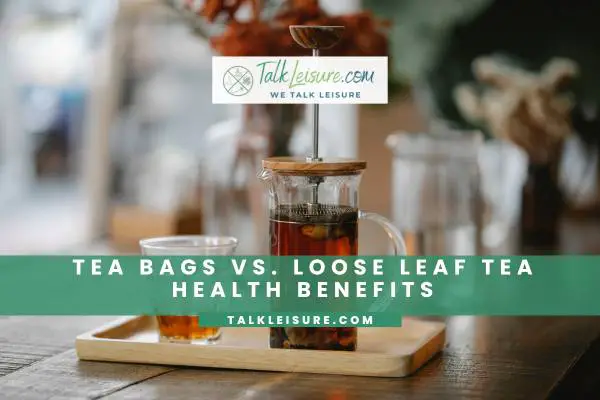
The health benefits of tea largely depend on the tea type and its preparation.
Loose-leaf tea, being less processed and containing whole or broken leaves, is believed to retain more antioxidants and beneficial compounds.
Some argue that tea bags, particularly those made of non-biodegradable materials, may release harmful chemicals during steeping.
Both tea bags and loose-leaf tea offer health benefits.
Tea bags provide convenience and are often pre-measured for consistent brewing.
Loose-leaf tea offers a more authentic tea experience, allowing leaves to expand for optimal flavor and antioxidants.
Loose-leaf tea might contain fewer processing and packaging materials, potentially reducing exposure to harmful chemicals.
However, tea bags can also retain antioxidants and nutrients due to their enclosed nature.
However, both forms of tea can contribute to a healthy lifestyle. Still, loose-leaf tea enthusiasts argue for a richer taste and potentially fewer additives, while tea bags offer convenience without compromising too much on health benefits.
Why Is Loose Leaf Tea Better Than Tea Bags?
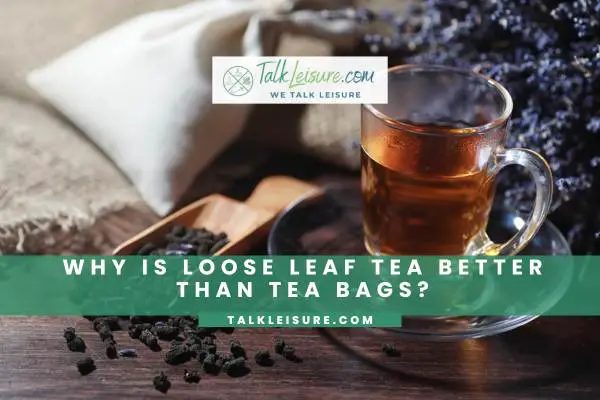
a) Environmentally Friendly:
Loose-leaf tea generates less waste since it does not require individual packaging like tea bags. Moreover, many tea brands that sell loose-leaf tea use biodegradable packaging, further reducing their environmental impact.
b) Quality Control:
Loose-leaf teas often undergo more stringent quality control measures, ensuring you get the best possible product. Quality control may be less rigorous with tea bags, especially those of lower grades.
c) Customization:
Brewing loose-leaf tea allows you to adjust factors such as steeping time, water temperature, and the amount of tea used, giving you more control over the taste and strength of your cup.
The Science (And Commerce) Behind Loose Leaf vs. Tea Bags:
Beyond personal preferences, there are scientific and commercial aspects to consider in the loose leaf vs. tea bags debate:
The debate between loose-leaf tea and tea bags encompasses science and commerce.
Loose-leaf tea, composed of whole leaves, offers a richer flavor profile due to a larger surface area and better infusion.
This provides a more nuanced taste and potential health benefits from intact compounds.
However, convenience and cost favor tea bags, which use fannings and dust, resulting in quicker brews but potentially compromising quality.
Commerce drives tea bag popularity, offering mass production and consistent flavors.
Despite this, discerning consumers seek the authentic experience of loose-leaf teas, valuing flavor and potential health perks over convenience.
What Is Whole Leaf Tea?
Whole-leaf tea refers to high-quality tea leaves that remain unbroken during processing, retaining their natural shape and size.
These teas often include young, tender leaves and buds known for their delicate flavors and aromas.
Whole-leaf tea consists of intact tea leaves that are minimally processed and retain their original shape.
Whole-leaf tea offers better flavor, aroma, and quality than tea bags containing broken leaves or fannings.
The leaves are hand-picked and carefully dried, preserving their essential oils and complex flavors.
When steeped, whole-leaf tea unfurls fully, allowing water to interact with the entire leaf surface, resulting in a richer, more nuanced taste.
This type of tea is often associated with premium loose-leaf teas and is considered superior due to its authenticity and depth of flavor.
A Comparison Between Whole Leaf Tea, Loose Leaf Tea, and Bagged Tea
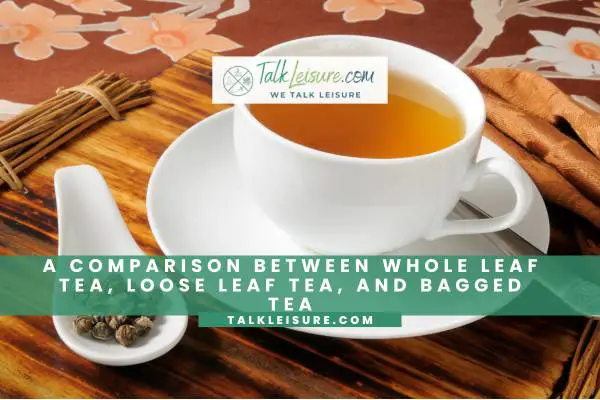
Whole-leaf tea falls under the category of loose-leaf tea since it is not enclosed in a bag or sachet.
In a broader sense, loose-leaf tea includes both whole and broken-leaf tea.
As mentioned earlier, bagged tea typically contains fannings or dust, which are small broken tea leaves.
Here’s a comparison table between Whole Leaf Tea, Loose Leaf Tea, and Bagged Tea:
| Aspect | Whole Leaf Tea | Loose Leaf Tea | Bagged Tea |
|---|---|---|---|
| Preparation | Requires breaking or | Requires measuring and | Convenient, pre-packaged |
| crumbling leaves | placing loose leaves | tea bags | |
| Leaf Quality | Whole, intact leaves | Leaves in various sizes | Smaller, broken leaves |
| Flavor and Aroma | Richer, nuanced flavor | Full, well-rounded | Milder, quicker infusion |
| and aroma | flavor and aroma | with less complexity | |
| Brewing Time | Generally longer | Longer brewing time | Shorter brewing time |
| Infusion Space | Requires more space | Requires a bit more | Limited infusion space |
| due to larger leaves | space than bagged tea | ||
| Control over | More control over | More control over | Limited control over |
| Brewing | brewing variables | brewing variables | brewing variables |
| Sustainability | Can be more sustainable | Generally more | Varies by brand and type |
| due to less processing | sustainable than bagged | ||
| Price | May be more expensive | Price varies, often | Usually more affordable |
| due to higher quality | higher quality than | than loose leaf | |
| and less processing | bagged tea | ||
| Variety and Selection | Wide range of options | Wide variety of options | Limited selection |
| in terms of tea types | in terms of tea types | and flavors | |
| Portability | Less portable due to | Moderately portable | Highly portable |
| larger leaves | with the use of | ||
| portable steeping | |||
| accessories |
Keep in mind that the characteristics of each type of tea can vary depending on the specific brand, quality, and preparation method.
Whole Leaf Tea vs. Tea Bags:
Whole-leaf tea offers a premium tea-drinking experience with delicate and nuanced flavors. These teas are often hand-picked and carefully processed to preserve their natural characteristics fully. On the other hand, tea bags, usually filled with smaller tea particles, are more about convenience and quicker brewing times than providing a complex flavor profile.
The Pros And Cons Of Loose Leaf Vs. Tea Bags
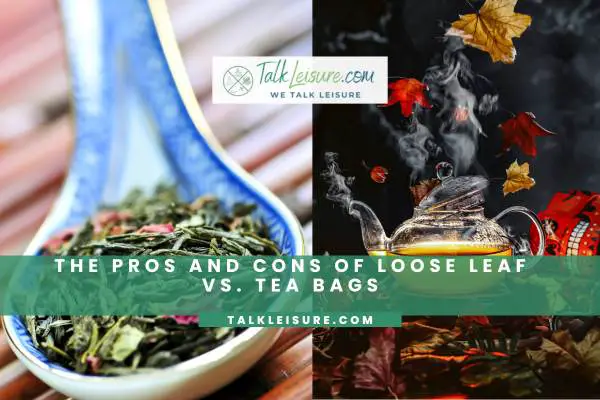
To help you weigh the pros and cons of each option, here’s a comparison:
Loose Leaf Tea: Pros:
- Richer flavor and aroma.
- Less processed and retains more health benefits.
- Eco-friendly with less packaging waste.
- Greater variety and customization.
Loose Leaf Tea: Cons:
- Requires an infuser or strainer for steeping.
- Steeping time may be longer.
Tea Bags: Pros:
- Convenient and easy to use.
- Quick brewing time.
- Portability for on-the-go tea drinking.
- Can be found in a wide variety of flavors.
Tea Bags: Cons:
- Often made from lower-grade tea leaves.
- Limited flavor complexity.
- Some bags may contain non-biodegradable materials.
- Less eco-friendly due to individual packaging.
Top Tea Brands With Premium Loose-Leaf And Tea Bags
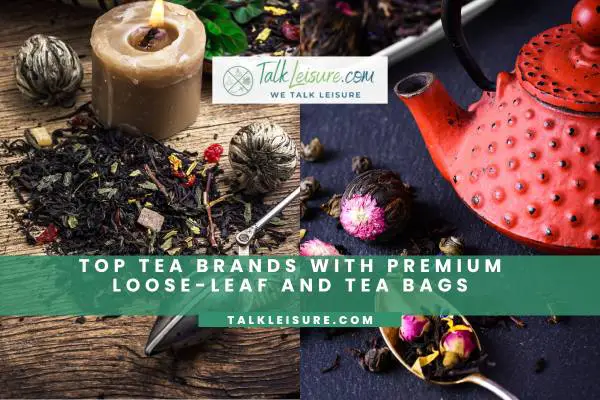
Here are some top tea brands known for their premium offerings:
Harney & Sons: Known for its extensive collection of high-quality teas, Harney & Sons offers a wide range of loose-leaf and tea bag options. They are renowned for their flavored, traditional blends and specialty teas.
Teavana: While Teavana had physical stores, it was known for its premium loose-leaf teas. However, as of my last update, some Teavana products might still be available through Starbucks stores and online platforms.
Tazo: Another brand associated with Starbucks, Tazo offers a variety of loose-leaf and tea bag options, including unique blends and flavors.
Adagio Teas: Adagio Teas is an online retailer that offers a wide range of high-quality loose-leaf teas. They have an extensive selection of traditional teas, flavored blends, and herbal infusions.
Numi Organic Tea: Numi is known for its organic and eco-friendly approach to tea production. They offer a variety of premium tea bags and loose-leaf teas, focusing on sustainability and quality.
Rishi Tea: Rishi Tea specializes in sourcing high-quality teas worldwide. They offer diverse loose-leaf teas, including single-origin teas and unique blends.
Mighty Leaf Tea: Mighty Leaf Tea is recognized for its handcrafted tea pouches, which provide ample space for loose leaves to unfurl and infuse. They offer a variety of premium blends and single-estate teas.
The Republic of Tea: This brand is known for its unique tea blends and creative flavors. They offer bagged and loose-leaf options and often incorporate health and wellness elements into their teas.
Davidson’s Organics: Davidson’s Organics offers a range of organic teas, including loose-leaf and tea bag options. They focus on sustainability and quality in their tea offerings.
Smith Teamaker: Smith Teamaker is known for its artisanal tea blending and brewing approach. They offer a variety of premium loose-leaf teas with a focus on craftsmanship.
Final Thoughts:
There is no definitive winner in the great debate between loose-leaf tea and tea bags.
Both options have unique strengths and weaknesses, catering to different preferences and lifestyles.
Loose-leaf tea appeals to those seeking a more sophisticated and customizable tea-drinking experience, while tea bags provide convenience and quick brewing for people on the go.
The best choice ultimately depends on your preferences, budget, and environmental considerations.
Loose-leaf tea might be your go-to option if you value exceptional flavor, health benefits, and sustainability.
FAQ:
How Much Loose Leaf Tea Equals A Tea Bag?
The amount of loose-leaf tea needed to equal a tea bag can vary depending on the brand and type of tea. As a general guideline, one standard tea bag typically contains 2 to 3 grams of tea. To approximate this in loose-leaf tea, you can use one teaspoon (approximately 2.5 grams) of loose-leaf tea per 8-ounce cup. However, remember that loose-leaf tea tends to have more volume than tea bags, so you may need to adjust the amount to suit your taste preferences.
What To Look For When Buying Tea?
When buying tea, there are several factors to consider:
- Tea Type: Determine the type of tea you prefer, such as black, green, white, oolong, or herbal tea.
- Quality: Look for reputable tea brands that prioritize quality. High-quality teas will provide a better flavor and overall experience.
- Origin: Consider the origin of the tea leaves. Different regions produce distinct flavor profiles.
- Processing: Understand the processing methods used, as they significantly impact the taste and health benefits of the tea.
- Packaging: Opt for tea brands that use eco-friendly and sustainable packaging materials.
Is Loose Leaf Tea Better Than Tea Bags?
As discussed throughout the article, tea enthusiasts often favor loose-leaf tea for its richer flavor, more nuanced aroma, and potential health benefits. However, tea bags offer unmatched convenience and quicker brewing times. Choosing between loose-leaf tea and tea bags depends on your preferences and priorities.
Best Wishes!

